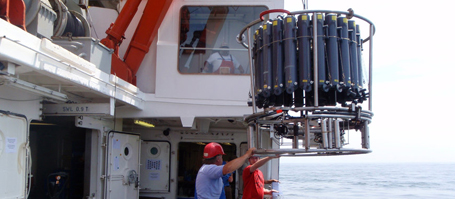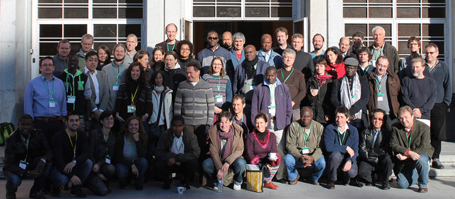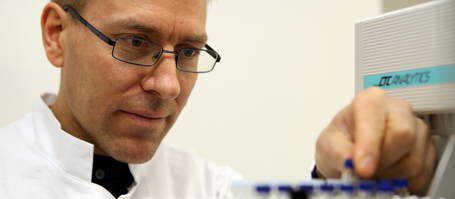The study was conducted within the framework of the Collaborative Research Center 754 “Climate - Biogeochemistry Interactions in the Tropical Ocean” and published in the online journal PLoS ONE.
Light, air and nutrients are essential for most organisms, on land as well as under water. However, these conditions are not met everywhere: Oxygen minimum zones exist in some parts of the tropical oceans, which means that the essential gas is only present in very small amounts or not at all. This is a natural phenomenon caused, for example, by the oxygen consuming decomposition of dead algae. Since 2007, scientists at the Collaborative Research Center 754 "Climate - Biogeochemistry Interactions in the Tropical Ocean", supported by GEOMAR Helmholtz Centre for Ocean Research Kiel and Kiel University, have been studying the Oxygen Minimum Zones and their effect on biocoenoses in the tropical oceans.
During an expedition of the Collaborative Research Centre 754 on the research vessel METEOR in January 2009, researchers from GEOMAR investigated the oxygen minimum zones off the coast of Peru in the South Pacific. There they discovered a gigantic cloud of dissolved hydrogen sulfide on the continental shelf: With a volume of approximately 440 cubic kilometers, the cloud was the largest ever recorded in an ocean. Hydrogen sulfide is a highly toxic compound that causes widespread death of fish and other marine organisms. Which organisms can survive such life threatening conditions and what role do they assume in the ecosystem? The scientists tried to find answers to these questions in the course of their expedition. The data gathered was used as the basis for a study that microbiologists Dr. Harald Schnuck, together with colleagues from Kiel University, the Max-Planck Institute for Marine Microbiology Bremen and Canadian Dalhousie University, Halifax, have now published in the online journal PLoS ONE.
“Actually we discovered a number of organisms that are superbly adapted to life in sulfuric water,” says Schnuck. This refers to different groups of particular bacteria called Proteobacteria. These possess a special type of metabolism: “They gain energy through the chemical decomposition of particular inorganic compounds, such as hydrogen sulfide. They do not need any light for this, in contrast to organisms that conduct light dependent photosynthesis. This process is called Chemolithoautotrophy,” explains Schnuck, who did his doctoral work on the topic of oxygen minimum zones at GEOMAR and who now works as a scientific assistant at Kiel University.
Moreover, the Proteobacteria are capable of transforming highly toxic hydrogen sulfide into nontoxic sulfate and thereby detoxifying the water for other organisms. The scientists involved in the study assume, however, that as a result of this process other organisms which produce hydrogen sulfide again on their part may increase. Owing to this, the sulfur laden oxygen minimum zones could remain stable for some time.
Due to climate change and an increase in nutrient content in the sea, it is expected that the spread and degree of oxygen minimum zones will increase in the coming years. Thus the researchers of the Collaborative Research Centre 754 calculate that hydrogen sulfide pollution comparable to the cloud found off Peru will occur more frequently. At the Collaborative Research Centre 754 oceanographers, biologists, biogeochemists, marine chemists, physicists, and atmospheric scientists work together closely to examine the predicted development and the resulting consequences for the ecosystem. “By including the new results in our computer models, we hope to make better predictions in cooperation with modelers and observers as to how frequently this phenomenon, which is critical for marine ecosystems, will occur in the future,” states the speaker of the Collaborative Research Centre 754, Prof. Andreas Oschlies from GEOMAR.
Original publication:
Schunck, H., G. Lavik, D. K. Desai, T. Großkopf, T. Kalvelage, C. R.
Löscher, A. Paulmier, S. Contreras, H. Siegel, M. Holtappels, P.
Rosenstiel, M. B. Schilhabel, M. Graco, R. A. Schmitz, M. M. M. Kuypers,
J. LaRoche (2013): Giant Hydrogen Sulfide Plume in the Oxygen Minimum
Zone off Peru Supports Chemolithoautotrophy. PLoS One
http://dx.doi.org/10.1371/journal.pone.0068661
Contact:
Dr. Harald Schunck (CAU, Institut für Allgemeine Mikrobiologie/GEOMAR, FB2-Chemische Ozeanographie)
hschunck@geomar.de
Jan Steffen (GEOMAR, Communication and Media), Tel.: 0431 600-2811
jsteffen@geomar.de
…



